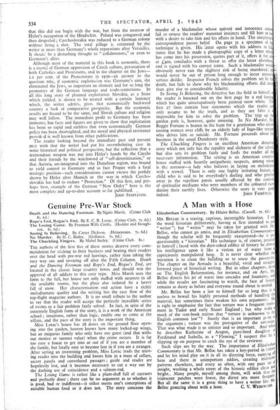Genuine Pre-War Stock
Death and the Dancing Footman. By Ngaio Marsh. (Crime Club 8s. 6d.)
THE authors of the first five of these stories deserve every com- mendation for sticking to their business and beating their readers over the head with pre-war red herrings, rather than taking the easy way out and trooping off after the Fifth Column. Death and the Dancing Footman and Rope's End, Rogue's End, are located in the classic large country house and should win the approval of all addicts to this cosy type. Miss Marsh uses the form to the full, her house not only stuffed with suspects in all the available rooms, but the place also isolated by a heavy fall of snow. Her characterisation and action have a richly melodramatic quality and the writing has the easy flow of the top-flight magazine authors. It is no small tribute to the author to say that the reader will accept the perfectly incredible series of events as a fair problem fairly solved. In fact, in spite of the extremely English form of the story, it is a work of the American school ; intuitions, rather than logic, enable one to come at the villain, and the pace of the story is the important thing.
Miss Lorac's house has 28 doors on the ground floor open- ing into the garden, heaven knows how many locked-up wings, but an exiguous family who only have one guest (and that with- out motive or susoect value) when the crime occurs. It is far too easy a house to get into or out of if you are a member of the family, but fatally easy to become lost in if you are a stranger. After setting an interesting problem, Miss Lorac leads the trust- ing reader into the building and looses him in a maze of cellars, secret panels and convoluted passages ; guide and reader are hopelessly lost, and it becomes necessary to cut a way out by the dashing use of coincidence and a salmon-rod.
The Losing Game is rather like a plum-duff full of currants and perfectly done"; there can be no argument as to whether it is good, bad or indifferent—it either meets one's conceptions of suitable human food or it does not. The story concerns the murder of a blackmailer whose naïveté and innocence canna fail to arouse the readers' maternal instincts and fill him or ha with a desire to take him and his affairs in hand. The simpletohi correspondence passes belief. On page 31 a specimen of ha technique is given. His :etter opens • with his address in furt, states that he has made a photographic copy of a letter which has come into his possession, quotes part of it, offers it for *- at Laoo, concludes with a threat to offer the letter elsewhere, and is signed with his correct name. Such a blackmailer wouit obviously never run the slightest risk of being murdered ; would never be out of prison long enough to incur anyone' -; serious dislike. Inspector French solves the problem set by - death, but fails to show why his blackmailing efforts did mar than give rise to considerable hilarity.
In Seeing Is Believing, the detective has the field to himself, the reader is knocKed out on the first page by a red herr which has quite unscrupulously been painted snow white. Th. first 27 lines contain four statements which the reader only assume to be the truth, and as they are false it impossible for him to solve the problem. The -trip up garden path is, however, quite amusing. In No Murder, Mr. Reggie Fortune is beaten in the hunt for a gentleman who enjoy§ tossing women over cliffs by an elderly lady of Iago-like temper who drives him to suicide. Mr. Fortune proceeds about his business in the usual Dundreary style.
The Chuckling Fingers is an excellent American detecti story which not only has the rapidity and slickness of the school, but also sets its problem fairly and feeds the reader all the necessary information. The setting is an American country. house stuffed with heartily antipathetic suspects, among whom is the narrator—a lady who believes in laying on melodrama with 3 trowel. There is only one highly irritating feature, a child who is said to be everybody's darling and who prattles away in the repellent patois usually affected by the controls of spiritualist mediums who were members of the coloured races during their earthly lives. Otherwise the story is very good


























 Previous page
Previous page